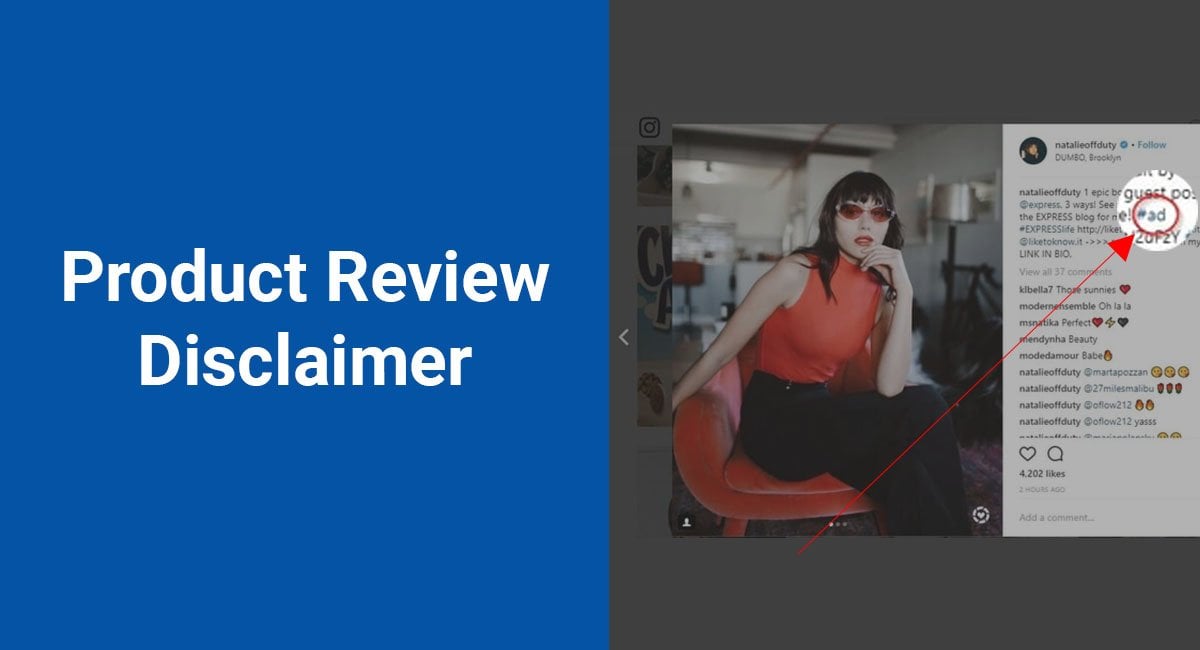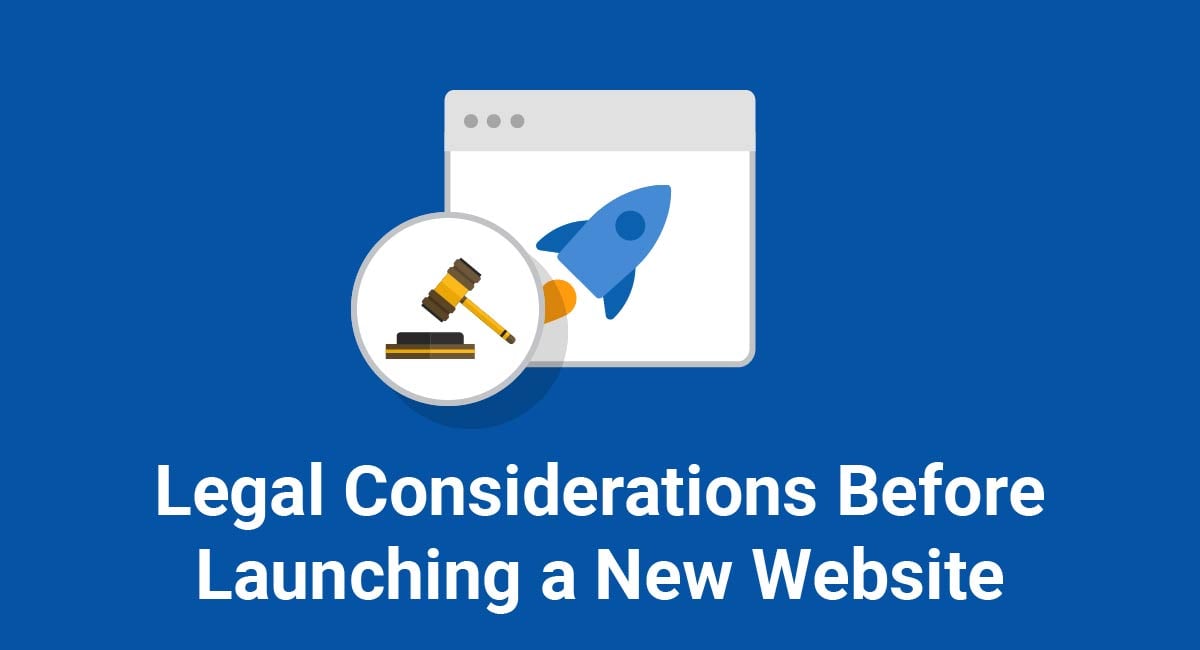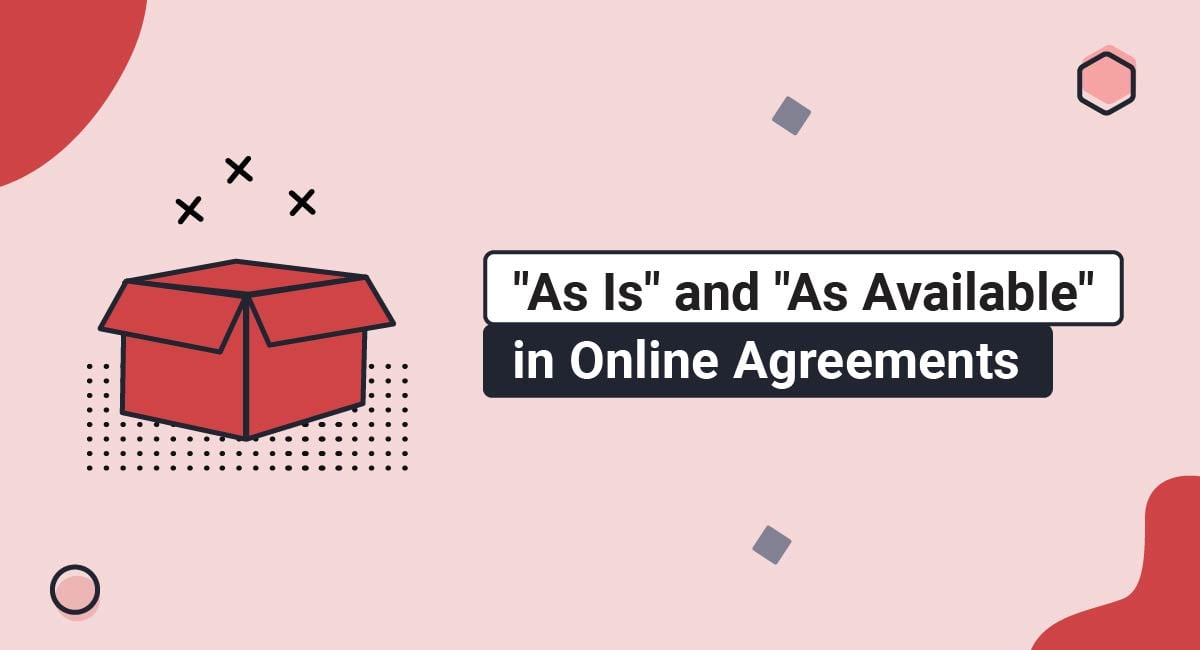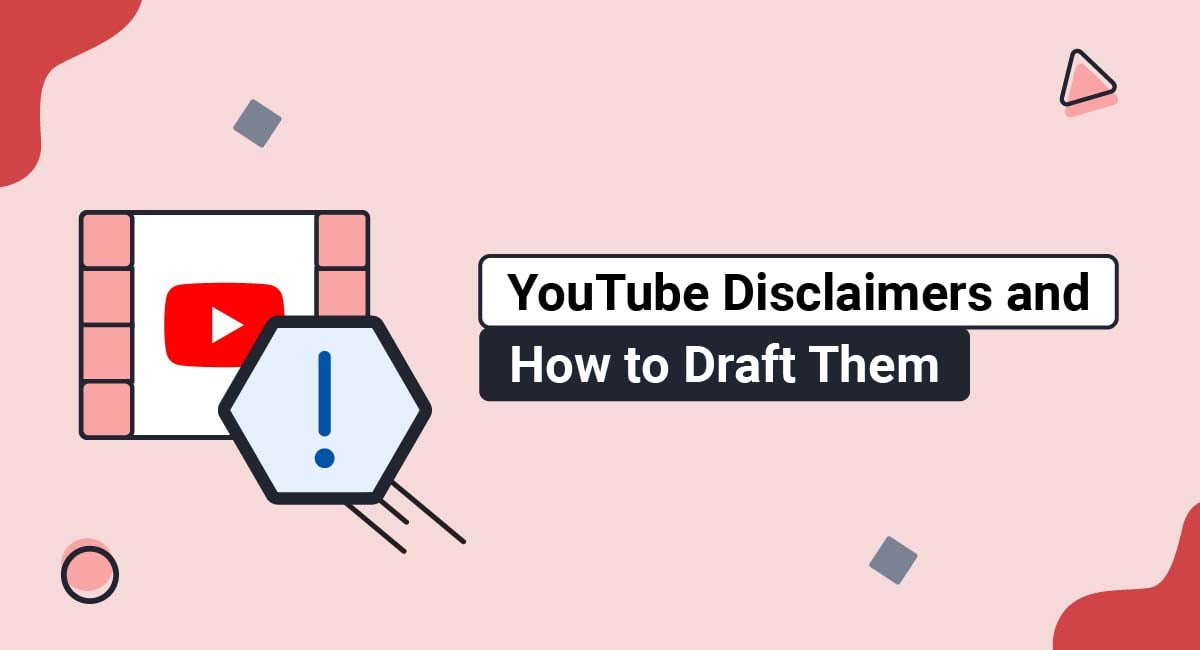If your website includes reviews you've done, you need to fulfill a few legal requirements. It doesn't matter whether these reviews are for your own products and services, or are reviews of other vendors' items. Either way, you must have a clearly written and noticeable review disclaimer.
Your disclaimer is a statement on your website or blog that gives your users specific information that may influence their perception of your site's content.
You want to be upfront with your site users. Tell them whether you received a payment to write a product review (or not). Let them know if the marketer or manufacturer of the product you are endorsing is a family member (or someone you know).
Your review may be honest, it likely is, but this information will affect the way someone reading your website will interact with it. So, they deserve to know about it.
The Federal Trade Commission (FTC) also thinks that your website users deserve to know such things.
That's why the FTC has made it a legal requirement that you use a disclaimer when you've been compensated in some way for your review and that compensation would potentially change the perception of the person reading your review.
Our Disclaimer Generator can generate a legal disclaimer for your business, website or mobile app. Just follow these steps:
-
At Step 1, select where your Disclaimer will be used.
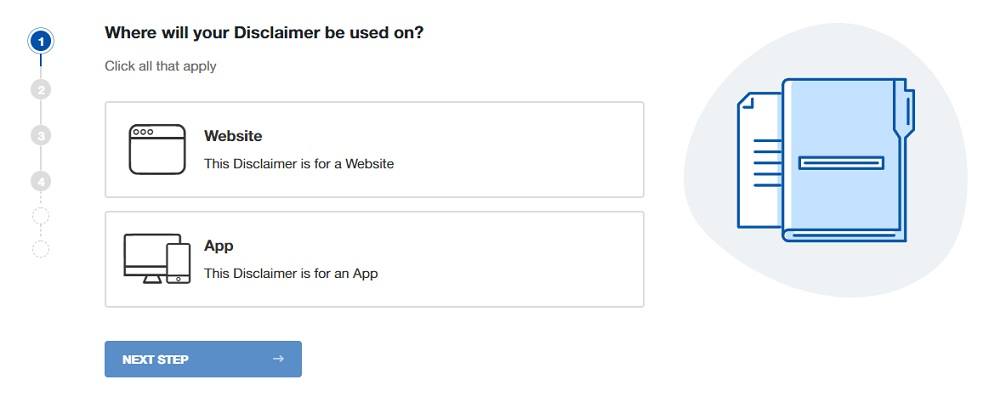
-
At Step 2, add in information about your website/app and business.
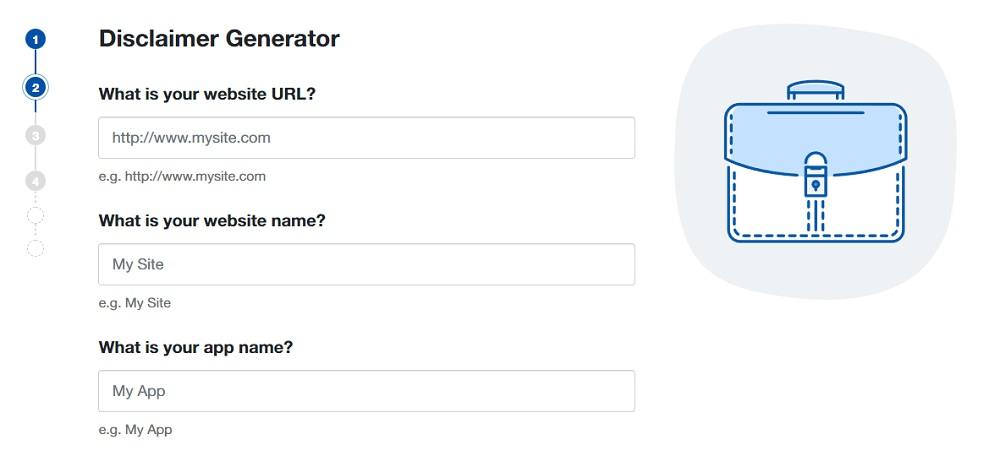
-
Answer some questions about your business practices.
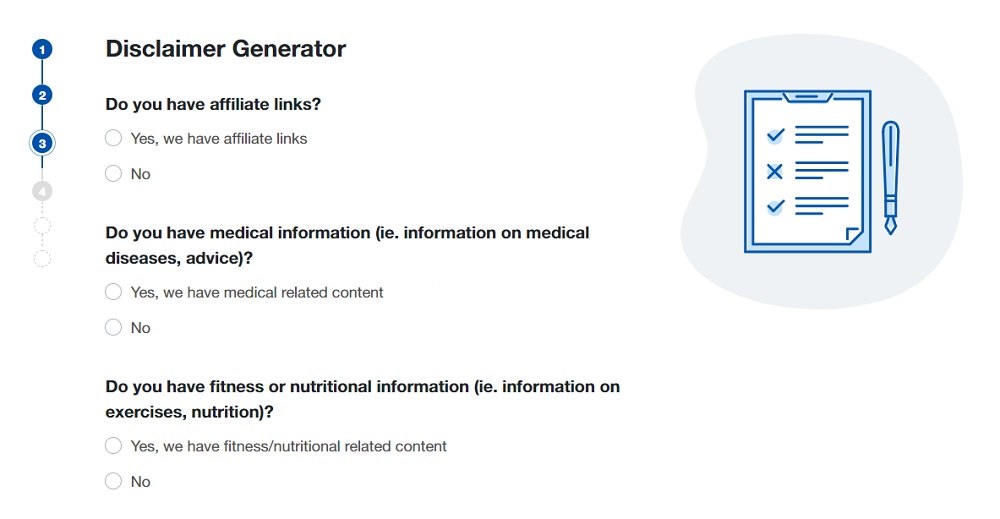
-
Enter an email address where you'd like to receive your Disclaimer and click "Generate."
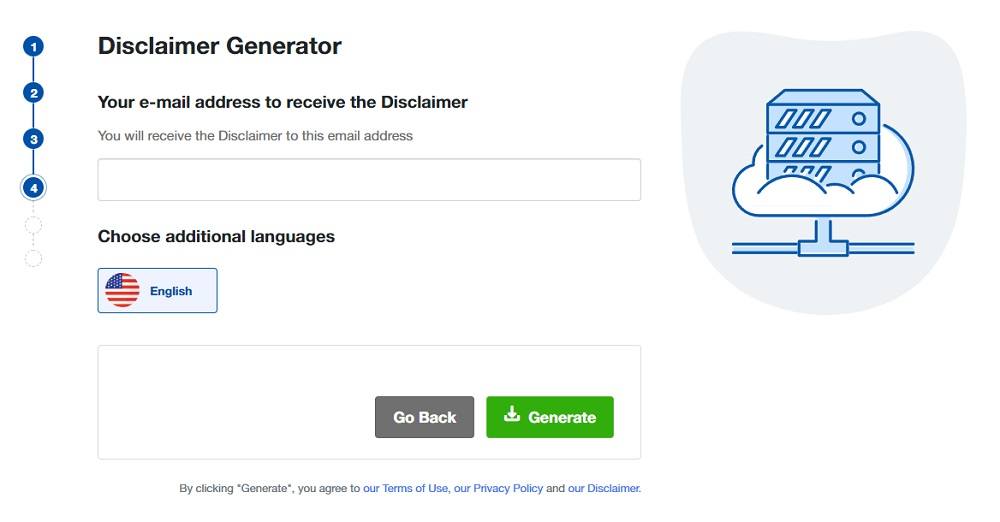
Done! You'll be able to instantly access and download your new Disclaimer.
- 1. Why use a Disclaimer?
- 2. What is a Product Review Disclaimer?
- 3. FTC Regulations on Disclaimers
- 4. When is it Necessary to Use a Product Review Disclaimer?
- 4.1. 1. When You Receive Any Compensation
- 4.2. 2. When Employees Promote Their Company's Products
- 4.3. 3. When You Post Pictures of Products
- 4.4. 4. When Someone Shares a Result That is Not Typical
- 4.5. 5. When You Run a Contest or Sweepstakes
- 5. How Your Disclaimer Can Help You?
- 6. It's All About an Honest Online Business Environment
Why use a Disclaimer?

The first answer to this question should be obvious by now: the law requires you to do so. We will discuss this later.
Secondly, a disclaimer is key for keeping in line with honest business practices.
If readers of your website or blog read an endorsement you give for a product and later find out you received a payment to make that endorsement, it robs you of your credibility. However, if you disclose the payment in the endorsement, it shows that you are honest and can be trusted.
What is a Product Review Disclaimer?

A product review disclaimer is a statement you add to your product review telling your readers you received compensation of some sort to do the review.
Michael Hyatt explains to his readers that every time they click on the links in his post, he receives a commission.

Disclaimers can be in the form of a statement as seen above when it comes to websites.
However, in the case of social media posts where there is a limitation of space, the FTC says you're still required to disclose that you received payment for your endorsement.
You can do this by adding the hashtag #ad or #advert.
FTC Regulations on Disclaimers

In 2009, the FTC published a set of guidelines governing endorsements, advertisements and testimonials.
The guidelines said that every advertisement that showed the effect or results of a consumer using a product as typical when it is in fact not so typical should disclose the real results that consumers can expect.
It also stated that you disclose "material connection," that is, payment of any kind between endorser and marketer that a consumer would not expect.
In 2013, the FTC updated these guidelines.
Like the original guidelines, the updates emphasized that protection of consumers applied across all platforms and devices.
However, the revised guidelines state that if any compensation or payment is involved between endorser and marketer, you must declare it with clarity. If there is any other situation, such as a family relationship, between endorser and marketer that would affect a consumer's decision, it too must be disclosed.
Consider some the information outlined below as you advertise, endorse and recommend products or services online.
1. Same laws for offline media apply online
The same laws instituted to protect consumers in other traditional media platforms apply to online platforms. The FTC Act's prohibition of "unfair or deceptive acts or practices" includes advertisements, sales, and marketing done online.
Many rules and guidelines of the FTC are not limited to an advertisement on a particular medium but also apply to a wide variety of online activities.
2. Your original product review or endorsement must carry the disclosure
Advertisers must incorporate applicable and qualifying information into the original claim. They should not have a separate disclosure qualifying the claim.
3. Your disclosures must be clear and conspicuous
A disclosure is clear and conspicuous based on its placement in the ad and how close it is to the claim. The closer the disclosure to the advert, the better. You must also consider the following;
- Is the disclosure prominent?
- Is the disclosure avoidable? Will the person reading the advert see the disclosure? If there is a chance they will not, it is not clear and conspicuous.
- Will the disclosure need to be repeated on different pages of your website?
- Are audio disclosures presented in loud enough volume and clear enough intonation?
- Do visual/video disclosure stay in the sight of the user for long enough?
- Is the language of the disclosure understandable to the target audience?
4. Make your disclosure clear and conspicuous by doing the following:
- The disclosure must be as close as possible to the advert or the product review that the disclosure addresses. After all, it's a disclosure for that product review.
- You need to take into consideration all the platforms and devices on which the disclosure will show. If your advert/review will show on a mobile device then you must find a way to make your disclosure also viewable.
Your disclosure may be, for example, incompatible with mobile platforms. If people read your review on their phones, then you must adjust your disclosure.
- When you have a space constraint on an ad that requires disclosure, you must still find a way to add the disclosure.
For example, if you're tweeting an endorsement, you must, in spite of the character limitation still add a disclosure. Adding a simple "#ad" in your post is an easy way to accomplish this.
If you for some reason absolutely cannot add a disclosure, add the disclosure to the page where the ad links.
- If you are going to hyperlink to your disclosure, there are a few instructions to follow.
The link must be clear to see.
- The label you give the hyperlink must convey the importance and relevance of the information it links to.
- The style with which you write your hyperlinks must be consistent so that your readers will know when there is a link available.
- The link should lead straight to the disclosure without any distractions.
- Watch your website analytics to see if the hyperlink is effective and adjust if you need to.
- Design your ads so that the user doesn't have to scroll to see the disclosure. If scrolling is unavoidable, then use visual cues to point your readers in the direction of the disclosure.
- Display your disclosure before the consumer can buy the product. For example, put the disclosure before the 'add to cart' button. Repeat the disclosure if you have to. Make sure you present the disclosure to the consumer enough times.
- Repeat the disclosure if the website is lengthy. It is possible for your readers to view a page from the beginning or go straight to the middle. Some will not scroll to the end of the page.
If it is possible for a user to read your product review or ad from the middle and get a wrong impression, then you need to repeat the disclosure. You also need to repeat the disclosure if you repeat the ad.
- If your product review or ad will lead your readers to a physical store, you must show them your disclosure on the ad itself. This is to avoid confusion or deception before they head to the store.
- Don't consign your disclaimers and disclosures to your Terms of Use and similar legal agreements.
- Display the disclosure on your website in a prominent position. The color, font size and graphic design of the disclosure should make it stand out on your site. Do not place any other elements that may distract from the disclosure on it.
- If you did your ad or product review in audio format, then your disclosure or disclaimer must also be in audio format. You must ensure the audio disclosure is at adequate volume and cadence in the review.
- Video disclosures should run for a duration long enough for viewers to notice them, watch or read and understand them.
- Use simple language so that your consumers can have a clear understanding of your disclosure.
5. If you can't display a clear and conspicuous disclaimer, don't post the review.
Product disclosures are critical to prevent an advertisement or product review from being deceptive and breaking any of the FTC guidelines. If it's for some reason not possible to display the disclosure in a clear and conspicuous way, don't run the ad or post the review.
This means that if a platform or a device will prevent a clear and conspicuous disclosure, then such platforms should not be able to distribute ads.
When is it Necessary to Use a Product Review Disclaimer?
Let's explore when a product review disclaimer is absolutely necessary for your site.
1. When You Receive Any Compensation

You must disclose whatever type of compensation you receive from a company that you are promoting or endorsing. Compensation is not limited to cash payment.
A company may decide to give you discounts or a gift card in exchange for promoting their business. You have to disclose this in the review. Sometimes all the company gives you is a free product, but you have to disclose this, too.
This requirement, of course, covers affiliates who get a commission when customers buy through the link they provide. Affiliate websites need to inform their readers that they make money when users click and buy through links on their sites.
2. When Employees Promote Their Company's Products

If an employee of a company promotes or endorses a product from that company, she should disclose her status as an employee. The reader of the endorsement has a right to know that you have a personal relationship with the product.
Shareholders and Investors in a company or a product must also add a disclosure to their endorsements. Every organization should inform their employees, investors, and shareholders to follow this policy.
3. When You Post Pictures of Products

With the rise in the use of social media, endorsements and promotions of products have become easier. You can post a picture on Instagram or Facebook as an endorsement in less than 30 seconds, and some posters can reach hundreds of thousands of viewers.
When you post a picture of a product and you have received some sort of compensation or incentive to post the picture, you must state that your post is an ad.
Here's an excerpt from the FTC's website below,

If you take a picture with an energy drink for example and post it on your Instagram page in exchange for payment, you have to label it as an ad.
You can do this by adding a hashtag #ad to the image as mentioned earlier.

The same goes for a tweet endorsing a product.
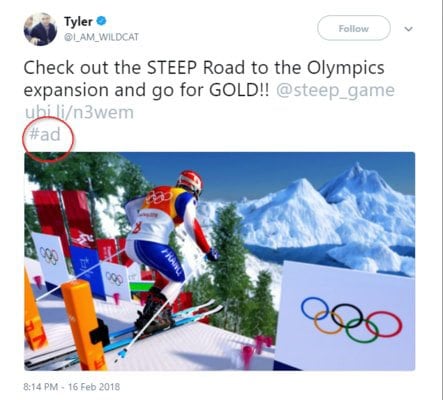
In March 2015, Lord & Taylor paid 50 fashion influencers to wear and post pictures of one of their new designs. The influencers received instructions to mention the @lordandtaylor handle. They also used the hashtag #DesignLab in the caption they displayed along with the picture.
The influencers, however, did not mention that they had received payment to post this pictures or that they received the dresses for free.
This social media campaign reached 11.4 million individuals, and the dress sold out very fast.
This got Lord & Taylor in trouble with the FTC for deceiving consumers.
4. When Someone Shares a Result That is Not Typical

If an endorsement or ad describes results that are atypical or uncommon, you should disclose this. If your result is unique or the product is not guaranteed to work for everybody in the same way, disclose this.
The disclaimer will tell your readers that they are not guaranteed the same results you had. This will prevent potential customers from purchasing the product with false information.
Below is an example of disclaimer from the Jenny Craig weight loss program that lets people know the results in the ad are not typical.
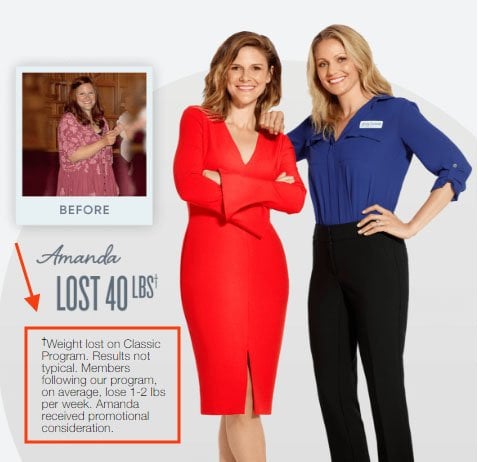
5. When You Run a Contest or Sweepstakes

When you put up posts on social media about sweepstakes, it is enough to add the hashtags #ad or #sweepstakes to the post. These hashtags are usable on all social outlets such as Facebook, Twitter, and Instagram.
If you are running a contest or sweepstakes and you need contestants to post on social media, inform the contestants to add the hashtag #sweepstakes to their posts. Or, they can use #ContestEntry instead. See an example from @Xbox below.
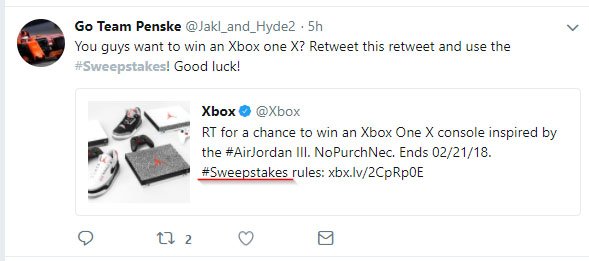
The times when you need to disclose are not limited to the situations listed above.
The FTC website answers a few questions and explains other scenarios where you need a disclaimer.

You need to add a disclaimer even when the money doesn't come to you in person.

If you even get something as small as a free meal, you need to disclose this.

By now you know a flight ticket and/or a hotel room would be enough to warrant a disclaimer.

An endorsement can be aspirational. As long as you are getting paid for what you're saying, you are required to disclose it.

Relationships that you need to disclose are not limited to family relationships.
How Your Disclaimer Can Help You?
You might be wondering if adding a disclaimer to your posts will reduce the number of clicks you get. It doesn't have to. In fact, your disclaimer may help you earn more clicks!
The internet has been around for a while now, and website users are very savvy about what they want. The internet has inundated them with sales and they have become less trusting of online advertising in general.
The only way to get past this is to earn their trust and the fastest, easiest way to do this is to tell them the truth.
Your honesty has to be upfront.
Don't sneak it in. Be bold and confident about it. You're being truthful after all, and that's a great thing.
Here's a disclaimer Brian Clark of copyblogger added to one of his posts:

Did he disclose that he benefited from the link? Yes.
Did he tell his audience the truth? Yes.
Did it improve his recommendation? Definitely!
You need to disclose with boldness - and a little creativity wouldn't hurt. If you're a solution provider for your readers and you add value to their lives, they probably wouldn't mind if you get compensation for their purchases.
You should, of course, let them know that your compensation does not increase the cost to them.
Brian Clark shows examples of Rae Hoffman, Frank Kern, Chris Brogan and their confident disclosure.
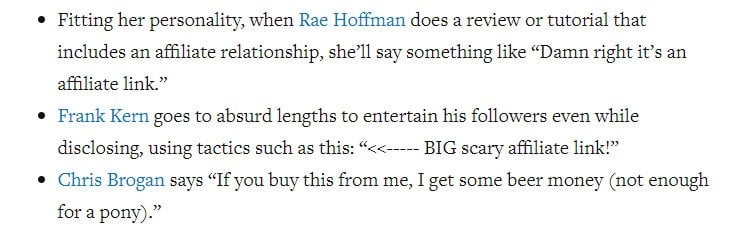
Note how each blogger revealed compensation with confidence.
It's All About an Honest Online Business Environment
Online commerce through the use of mobile and social marketing is booming. Deception and dishonesty can reduce consumer confidence in online businesses. Consumers need a guarantee that the products and services you sell to them online are what they pay for.
Most of the general ethics that guide advertising law also apply to online advertisements. As new technologies emerge, new ethical issues arise.
Government regulatory bodies will continue to check online marketing and advertising and develop new guidelines. You must follow these guidelines so you can build an honest, trusting environment for your consumers.

Comprehensive compliance starts with a Privacy Policy.
Comply with the law with our agreements, policies, and consent banners. Everything is included.
